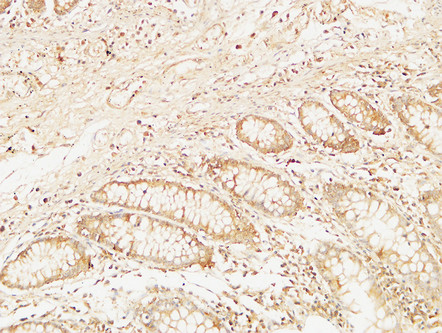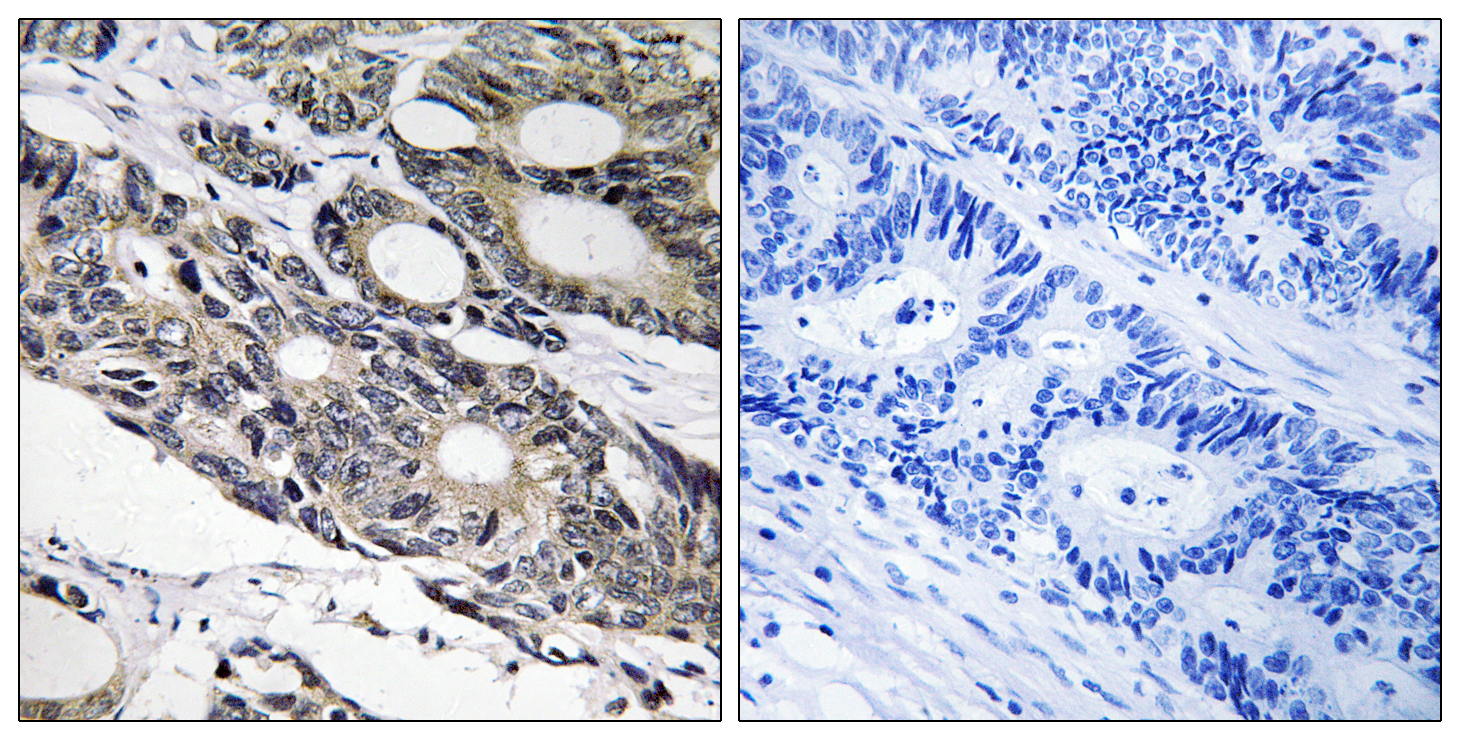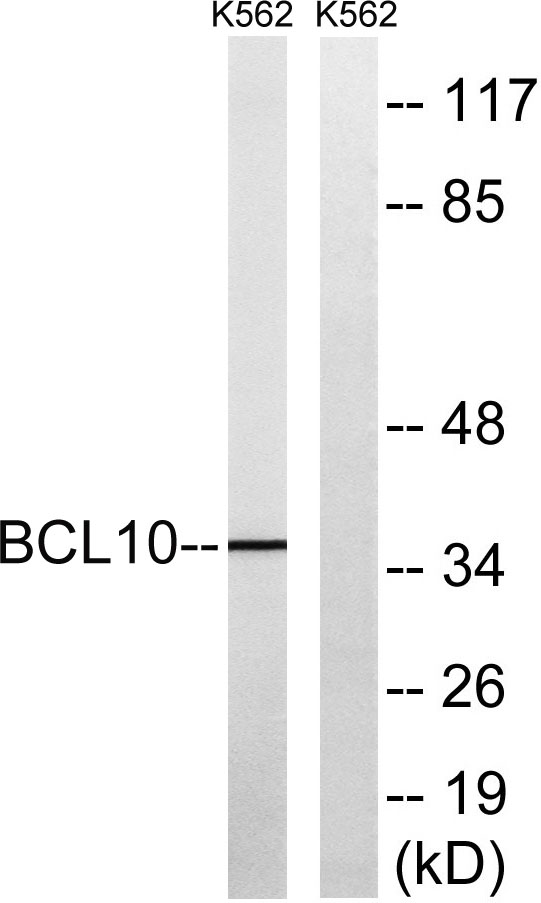Bcl-10 Polyclonal Antibody
- Catalog No.:YT0468
- Applications:WB;IHC;IF;ELISA
- Reactivity:Human;Mouse;Rat
- Target:
- Bcl-10
- Fields:
- >>NF-kappa B signaling pathway;>>C-type lectin receptor signaling pathway;>>T cell receptor signaling pathway;>>B cell receptor signaling pathway;>>Shigellosis;>>Tuberculosis
- Gene Name:
- BCL10
- Protein Name:
- B-cell lymphoma/leukemia 10
- Human Gene Id:
- 8915
- Human Swiss Prot No:
- O95999
- Mouse Gene Id:
- 12042
- Mouse Swiss Prot No:
- Q9Z0H7
- Rat Gene Id:
- 83477
- Rat Swiss Prot No:
- Q9QYN5
- Immunogen:
- The antiserum was produced against synthesized peptide derived from human BCL10. AA range:111-160
- Specificity:
- Bcl-10 Polyclonal Antibody detects endogenous levels of Bcl-10 protein.
- Formulation:
- Liquid in PBS containing 50% glycerol, 0.5% BSA and 0.02% sodium azide.
- Source:
- Polyclonal, Rabbit,IgG
- Dilution:
- WB 1:500 - 1:2000. IHC 1:100 - 1:300. ELISA: 1:40000.. IF 1:50-200
- Purification:
- The antibody was affinity-purified from rabbit antiserum by affinity-chromatography using epitope-specific immunogen.
- Concentration:
- 1 mg/ml
- Storage Stability:
- -15°C to -25°C/1 year(Do not lower than -25°C)
- Other Name:
- BCL10;CIPER;CLAP;B-cell lymphoma/leukemia 10;B-cell CLL/lymphoma 10;Bcl-10;CARD-containing molecule enhancing NF-kappa-B;CARD-like apoptotic protein;hCLAP;CED-3/ICH-1 prodomain homologous E10-like regulator;CIPER;Cellular homolog
- Observed Band(KD):
- 36kD
- Background:
- This gene was identified by its translocation in a case of mucosa-associated lymphoid tissue (MALT) lymphoma. The protein encoded by this gene contains a caspase recruitment domain (CARD), and has been shown to induce apoptosis and to activate NF-kappaB. This protein is reported to interact with other CARD domain containing proteins including CARD9, 10, 11 and 14, which are thought to function as upstream regulators in NF-kappaB signaling. This protein is found to form a complex with MALT1, a protein encoded by another gene known to be translocated in MALT lymphoma. MALT1 and this protein are thought to synergize in the activation of NF-kappaB, and the deregulation of either of them may contribute to the same pathogenetic process that leads to the malignancy. Alternative splicing results in multiple transcript variants. [provided by RefSeq, Mar 2016],
- Function:
- disease:A chromosomal aberration involving BCL10 is recurrent in low-grade mucosa-associated lymphoid tissue (MALT lymphoma). Translocation t(1;14)(p22;q32). Although the BCL10/IgH translocation leaves the coding region of BCL10 intact, frequent BCL10 mutations could be attributed to the Ig somatic hypermutation mechanism resulting in nucleotide transitions.,disease:Defects in BCL10 are involved in various types of cancer.,function:Promotes apoptosis, pro-caspase-9 maturation and activation of NF-kappa-B via NIK and IKK. May be an adapter protein between upstream TNFR1-TRADD-RIP complex and the downstream NIK-IKK-IKAP complex. Is a substrate for MALT1.,PTM:Phosphorylated. Phosphorylation results in dissociation from TRAF2 and binding to BIRC2/c-IAP2.,similarity:Contains 1 CARD domain.,subcellular location:Appears to have a perinuclear, compact and filamentous pattern of expression. Also
- Subcellular Location:
- Cytoplasm, perinuclear region . Membrane raft . Appears to have a perinuclear, compact and filamentous pattern of expression. Also found in the nucleus of several types of tumor cells. Colocalized with DPP4 in membrane rafts. .
- Expression:
- Ubiquitous.
MALT1 Protease Regulates T-Cell Immunity via the mTOR Pathway in Oral Lichen Planus INFLAMMATION Wang Xiao-Feng IHC,WB Human 1:200,1:1000 oral mucosa tissue Jurkat T cell
- June 19-2018
- WESTERN IMMUNOBLOTTING PROTOCOL
- June 19-2018
- IMMUNOHISTOCHEMISTRY-PARAFFIN PROTOCOL
- June 19-2018
- IMMUNOFLUORESCENCE PROTOCOL
- September 08-2020
- FLOW-CYTOMEYRT-PROTOCOL
- May 20-2022
- Cell-Based ELISA│解您多样本WB检测之困扰
- July 13-2018
- CELL-BASED-ELISA-PROTOCOL-FOR-ACETYL-PROTEIN
- July 13-2018
- CELL-BASED-ELISA-PROTOCOL-FOR-PHOSPHO-PROTEIN
- July 13-2018
- Antibody-FAQs
- Products Images

- Immunohistochemical analysis of paraffin-embedded Human colon. 1, Antibody was diluted at 1:100(4° overnight). 2, High-pressure and temperature EDTA, pH8.0 was used for antigen retrieval. 3,Secondary antibody was diluted at 1:200(room temperature, 30min).

- Immunohistochemistry analysis of paraffin-embedded human colon carcinoma tissue, using BCL10 Antibody. The picture on the right is blocked with the synthesized peptide.

- Western blot analysis of lysates from K562 cells, using BCL10 Antibody. The lane on the right is blocked with the synthesized peptide.



